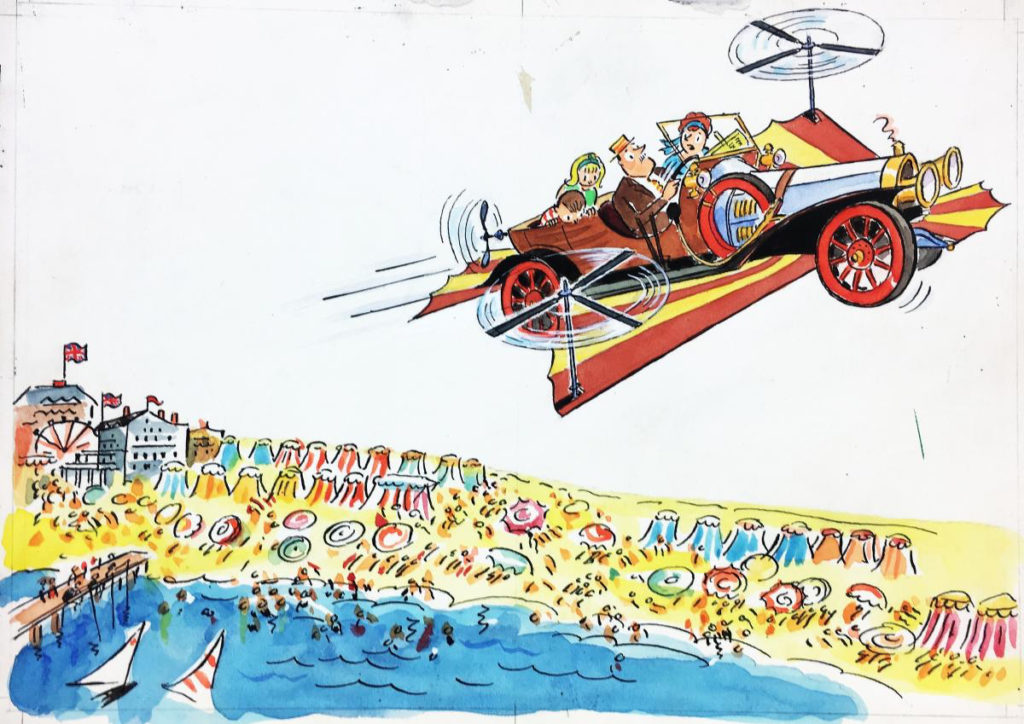Chitty Chitty Bang Bang, illustrated by Barney Tobey, is on display at the New-York Historical Society. This is not Ian Fleming’s novel, his only work for children. Nor is it the 1968 film starring Dick Van Dyke and Sally Ann Howe. The illustrations on display are from a picture book tie-in to the film, adapted for beginning readers by Al Perkins.
In April 1961, amid a lawsuit disputing the authorship of Thunderball, Ian Fleming suffered a major heart attack. While recuperating in a south coast hotel, he set down some of the nightly bedtime stories he invented and told to his son Caspar. Chitty Chitty Bang Bang! The Magical Car follows the Pott family—father Caractacus (“the Commander”), mother Mimsie, and twins Jeremy and Jemima—and their semi-autonomous, gadget-laden car. The novel was illustrated by John Burningham and published in October 1964, two months after Fleming’s death (from another heart attack, on Caspar’s twelfth birthday).
The grim circumstances surrounding Chitty’s creation and publication seem to stake out a presence in Burningham’s original illustrations. His characters are stolid and compact, with small eyes and short lines for mouths. Burningham’s England and France are foreboding places, full of smog, cobwebs, and dark shadows, into which the Pott family ventures to explore a gunrunner’s cave and face off against the villainous Monster Joe and his gangsters.
The 1968 film is a production of the post-Fleming James Bond machine. It was produced by Cubby Broccoli, written by Roald Dahl (“You Only Live Twice”), and featured Desmond Llewelyn (“M” in seventeen films) and Gert Fröbe (“Goldfinger”). Special effects were overseen by John Stears, who worked on six Bond films and won an Academy Award for “Thunderball.” Dahl’s screenplay offers a loose adaptation of Fleming’s story. Gone are Monster Joe and the gloomy French coast, replaced by Baron Bomburst, the Child Catcher, and the autocratic land of Vulgaria. Commander Pott is no longer a married naval man, but a handsome widower-inventor-storyteller named Potts. Mimsie Pott is replaced by the beautiful, upper-class Truly Scrumptious, whose name plays like an infantilized “Pussy Galore” (with all the bad taste therein). The film is giddy, bright, and high energy—in many ways, just the opposite of Burningham’s vision.
The “Chitty” picture book falls somewhere in between novel and film. Perkins stays mostly faithful to the original story, reducing Fleming’s prose into bite-sized sentences. This is a children’s version of a children’s novel. The resulting story is simple, less complex and less interesting than its counterparts. It is rescued from utter tedium by the quality of Tobey’s illustrations.
Barney Tobey was a lifelong New Yorker and longtime resident of the Upper West Side (the exhibition’s location, on the corner of Seventy-seventh Street and Central Park West, is fitting). Tobey is best known for his work in The New Yorker, including four covers and over 1,200 cartoons. His “Chitty” inhabits a separate world from Burningham’s originals (although not so far as Vulgaria). Paris is no longer gloomy, but lush and green by day, and full of twinkling stars by night. His Pott family, painted in bright watercolor and gouache, are wide-eyed with gaping mouths. Joe the Monster wears a red ascot and beret. Mrs. Pott, in a blue sleeveless dress, shares a peanut butter sandwich with the mustachioed French chief of police.
In a New York Times review of a 1976 Tobey show at the Nicholls Gallery, John Russell wrote of the cartoonist’s unique ability to bring drawing and caption into perfect equilibrium. Perkins’s “Chitty” doesn’t give him much of a platform, but Tobey nonetheless delivers a dynamic story with his illustrations (such a comment about equilibrium, applied to children’s books, might better be applied to the partnership of Dahl and Quentin Blake).
The New-York Historical Society exhibit displays page proofs from the picture book Chitty Chitty Bang Bang alongside Tobey’s preparatory studies on Bainbridge board. Also on display are several studies for New Yorker cartoons. Skip the Philco Transitone radio, which plays “Chitty Chitty Bang Bang,” the Academy Award–nominated theme song by Robert and Richard Sherman. It is nearly unlistenable.

